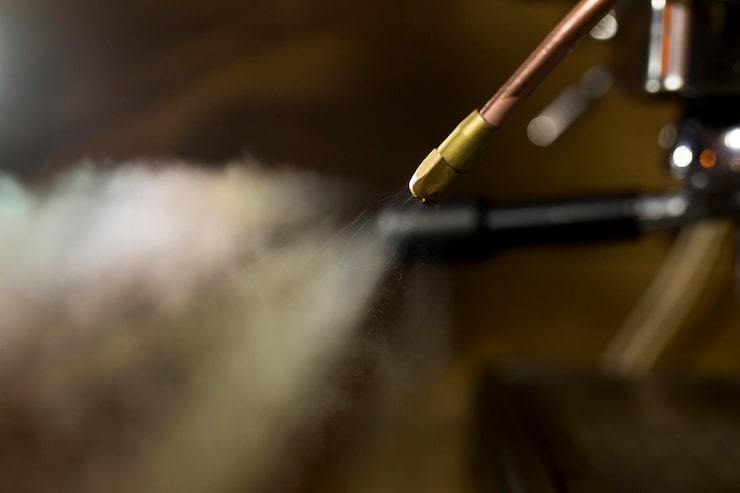The question “What is the process of static powder coating?” is one that many manufacturers, engineers, and DIY professionals ask when seeking a durable and eco-friendly surface finishing solution. Static powder coating is a dry finishing process in which fine powder particles are applied to a surface using electrostatic forces, then cured in a high-temperature oven to create a tough, attractive, and protective layer. Compared with wet painting, it produces higher durability, better coverage, and no harmful solvent emissions, making it a preferred choice across industries.

To understand the powder coating process steps, it is important to start with surface preparation. Any metal surface must be thoroughly cleaned to remove grease, dirt, rust, or oxidation. This can be done with alkaline cleaning solutions, high-pressure washing, or chemical baths. In heavy-duty applications, abrasive blasting such as sandblasting or shot blasting is used to create a slightly roughened surface, which improves adhesion. Chemical treatments like phosphate or chromate coatings are sometimes applied to enhance corrosion resistance. Drying the parts completely is essential before moving to the application stage, as even minimal moisture can affect the final coating quality.
The next step in the process of static powder coating is the electrostatic powder application. A powder coating spray gun charges the powder particles—either through corona charging or tribo charging—while the part being coated is grounded. This creates an electrostatic attraction that draws the powder particles onto the surface, ensuring even coverage, including hard-to-reach corners and complex shapes. Because of the way the particles are charged, the transfer efficiency is high, and overspray can often be collected and reused, reducing material waste.
Once the coating layer is applied, the workpiece is placed into a powder coating oven for curing. This stage uses heat, typically between 160°C and 200°C, for a duration of 10 to 30 minutes depending on the powder formula and coating thickness. During curing, the powder melts, flows together, and chemically crosslinks, forming a solid and uniform film. Most industrial applications use thermosetting powders—epoxy, polyester, or polyurethane—that offer excellent mechanical strength, corrosion resistance, and long-term durability. Maintaining accurate oven temperature and air circulation is critical to avoiding undercured or overbaked finishes.
After curing, the coated part is cooled to room temperature and undergoes quality inspection. This may include visual examination for surface smoothness and color uniformity, film thickness measurement, adhesion testing, and impact or abrasion resistance testing. The goal is to ensure the finish meets both aesthetic and functional requirements. High-quality static powder coating should be free of defects such as pinholes, orange peel texture, or uneven gloss.
The advantages of powder coating make it highly competitive in manufacturing. It produces a finish that resists chipping, scratching, and fading, while also withstanding harsh environmental conditions. It is also environmentally friendly, as it contains no solvents and releases no volatile organic compounds (VOCs). From a business standpoint, the high material utilization rate reduces costs, and the ability to apply thick coatings in one pass increases production efficiency. A wide range of colors, textures, and effects—such as metallic, matte, gloss, and wrinkle finishes—offers design flexibility for branding and product customization.
Because of these benefits, the applications of static powder coating span multiple industries. In automotive manufacturing, it is used for alloy wheels, chassis components, and under-hood parts. In the appliance sector, it is applied to refrigerators, washing machines, and ovens for both protection and appearance. Architectural uses include aluminum window frames, steel railings, and fencing, where durability against weathering is important. Furniture manufacturers apply powder coating to office desks, shelving, and outdoor furniture for both aesthetic appeal and resistance to wear. In electronics, powder coating protects enclosures and control panels from corrosion and mechanical damage.
Several factors influence the quality of the powder coating process. Proper cleaning and surface preparation are essential. The powder particle size and distribution affect smoothness and coverage. Spray gun settings—such as voltage, powder flow rate, and spray distance—must be optimized. Oven curing time and temperature profiles need precise control. Even environmental conditions in the spray booth, such as humidity and air cleanliness, can impact electrostatic efficiency and coating quality. Controlling these factors ensures that the finish meets performance specifications consistently.
Looking at future trends in static powder coating, several innovations are emerging. Low-temperature curing powders now allow coating of heat-sensitive materials like plastics and composites. Antimicrobial coatings are being developed for use in medical equipment and food processing facilities. Ultra-durable outdoor powders provide enhanced UV resistance for long-term color retention. Robotics and automation are increasingly used to improve consistency and throughput in production lines. In addition, advanced powder recovery systems help capture overspray, enabling near-zero waste operations.
For manufacturers, designers, and engineers who ask, “What is the process of static powder coating?”, the answer involves a careful sequence of steps—surface preparation, electrostatic application, controlled curing, and rigorous quality inspection—that together create a high-performance and environmentally responsible coating. Its combination of durability, cost efficiency, and visual versatility explains why powder coating continues to gain popularity across industries worldwide.


